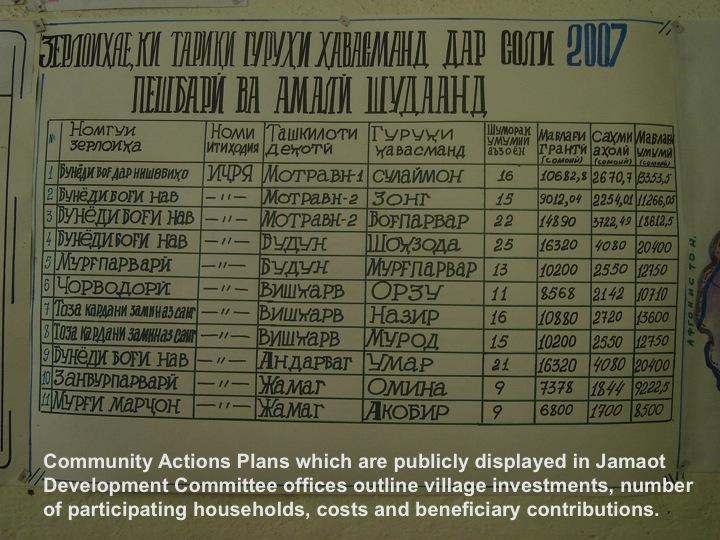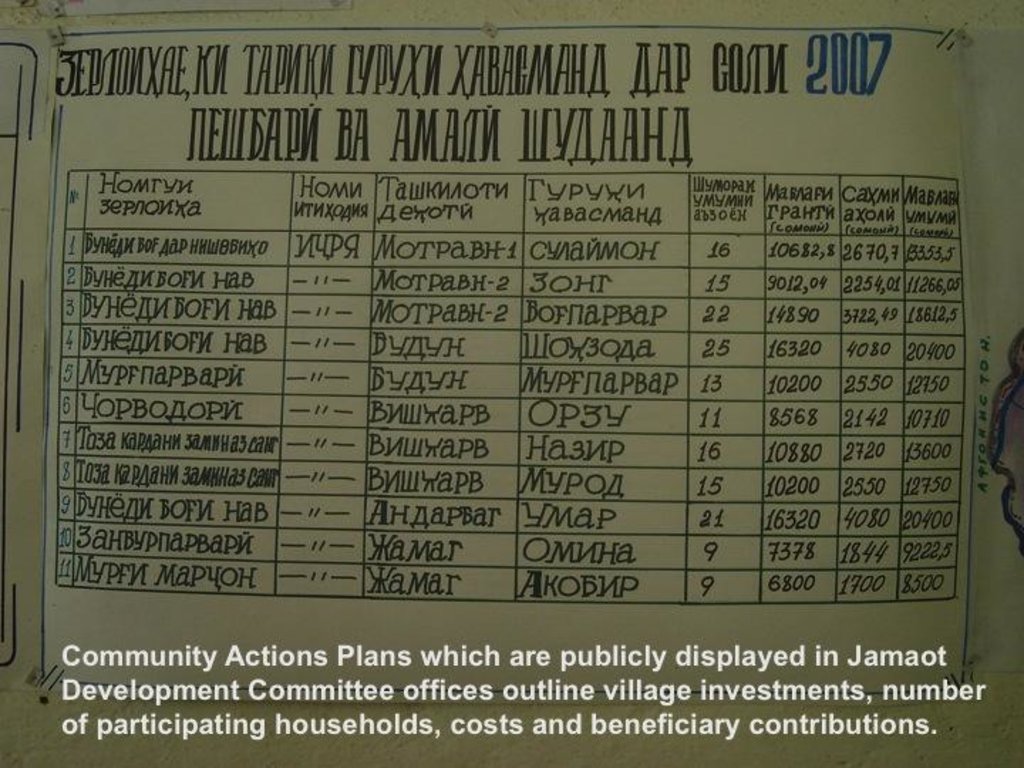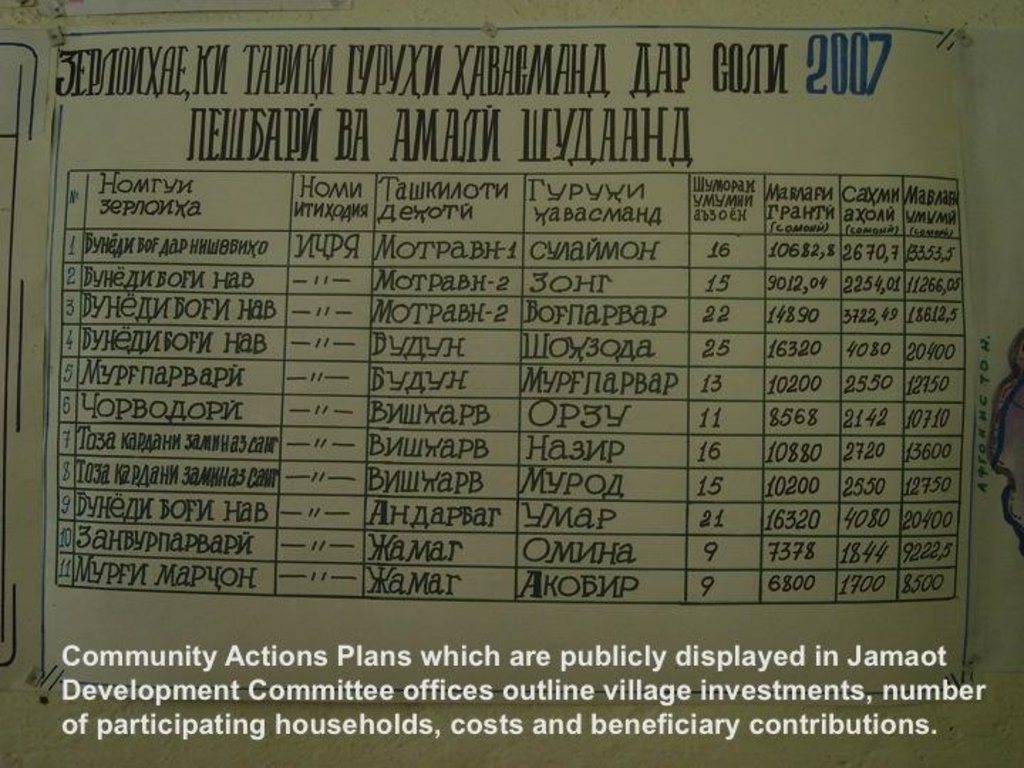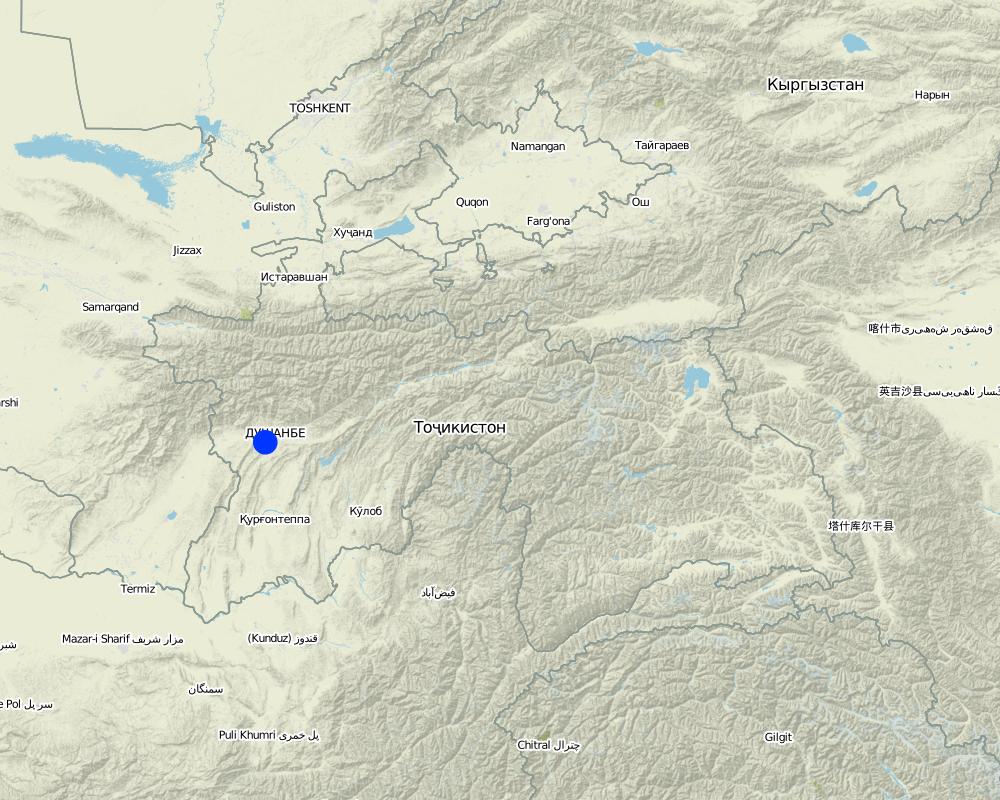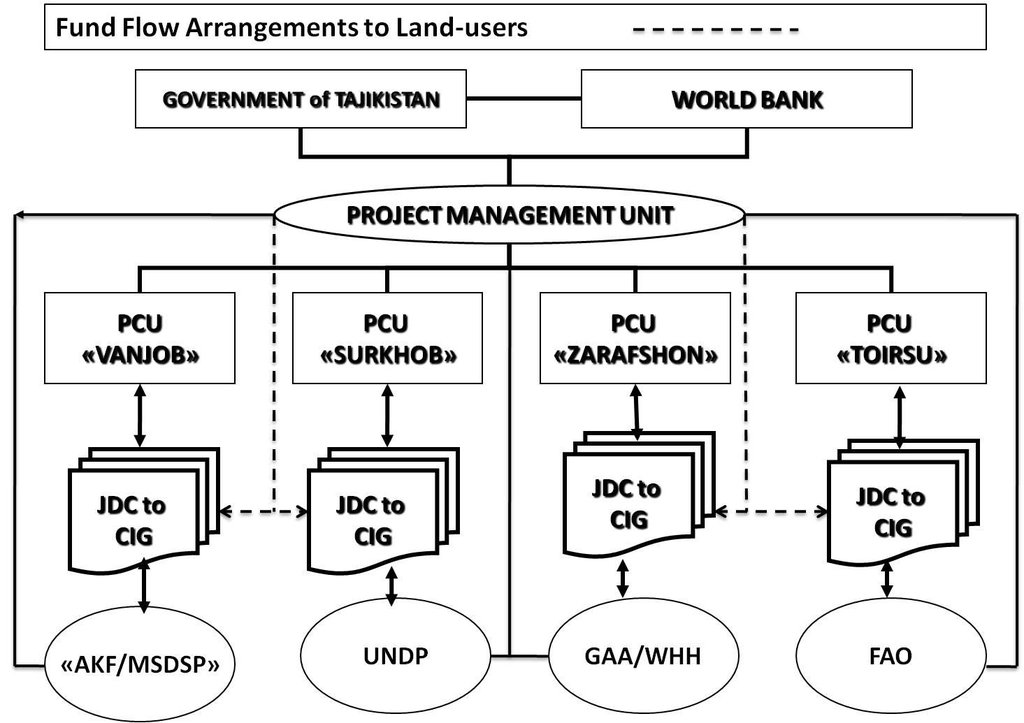SLM small grant allocation mechanisms [ຕາຈິກິສະຕານ]
- ການສ້າງ:
- ປັບປູງ:
- ຜູ້ສັງລວມຂໍ້ມູນ: Nandita Jain
- ບັນນາທິການ: –
- ຜູ້ທົບທວນຄືນ: David Streiff
approaches_2453 - ຕາຈິກິສະຕານ
ເບິ່ງພາກສ່ວນ
ຂະຫຍາຍທັງໝົດ ຍຸບທັງໝົດ1. ຂໍ້ມູນທົ່ວໄປ
1.2 ລາຍລະອຽດ ການຕິດຕໍ່ ຂອງບຸກຄົນທີ່ຊັບພະຍາກອນ ແລະ ສະຖາບັນ ການມີສ່ວນຮ່ວມ ໃນການປະເມີນຜົນ ແລະ ເອກະສານ ຂອງວິທີທາງ
ຜູ້ຊ່ຽວຊານ ດ້ານການຄຸ້ມຄອງ ທີ່ດິນແບບຍືນຍົງ:
Mott Jessica
World Bank
ຊື່ຂອງ ສະຖາບັນການຈັດຕັ້ງ ທີ່ອໍານວຍຄວາມສະດວກ ໃນການສ້າງເອກກະສານ ຫຼື ປະເມີນແນວທາງ (ຖ້າກ່ຽວຂ້ອງ)
World Bank (World Bank) - ສະຫະລັດອາເມລິກາ1.3 ເງື່ອນໄຂ ຂອງການນໍາໃຊ້ເອກກະສານຂໍ້ມູນ ຂອງ WOCAT
ຜູ້ສັງລວມ ແລະ ບັນດາຜູ້ຕອບແບບສອບຖາມ ຍອມຮັບໃນເງື່ອນໄຂ ການນໍາໃຊ້ຂໍ້ມູນເອກະສານ ທີ່ສ້າງຂື້ນ ໂດຍຜ່ານ ອົງການ WOCAT:
ແມ່ນ
2. ພັນລະນາ ແນວທາງການຄຸ້ມຄອງນໍາໃຊ້ດິນແບບຍືນຍົງ
2.1 ການອະທິບາຍ ໂດຍຫຍໍ້ ຂອງວິທີທາງ
Mechanisms to facilitate participatory decision-making about grant allocation among land users and improve transparency and accountability in flow of funds to beneficiaries in small-grant programmes for SLM.
2.2 ການອະທິບາຍ ລາຍລະອຽດ ຂອງວິທີທາງ
ການອະທິບາຍ ລາຍລະອຽດ ຂອງວິທີທາງ:
Aims / objectives: As part of the Community Agriculture & Watershed Management Project (CAWMP), this approach helped beneficiaries and project partners allocate grants and manage the flow of funding while promoting fairness, transparency, and ownership. It facilitated appropriate SLM choices across the highly variable agricultural, climatic and geographic conditions. Almost 4000 rural investments including SLM technologies were implemented, resulting in over 96,000ha under improved land management practices and benefits for more than 43,000 households in Tajikistan’s uplands.
Methods: This approach set a fixed budget per village, limited the grant value received per household as well as the total size of any one grant, required minimum levels of beneficiary contributions, and provided grant money to beneficiaries, enabling them to purchase the inputs.
Stages of implementation: Fixed village budget: In their Community Action Plans (CAP) villages assigned priorities to grants within a set budget amount for the entire village. Project guidelines specified a formula for this budget based on amounts per investment type per household excluding beneficiary contributions ($30/household for farm productivity, $74/household for land management, and $30/household for rural infrastructure). The number of households in a village multiplied by these per-household-amounts determined the overall size of the grant funding for that village. Grant allocation limits. The villages were informed of their overall budget as well as the household limits for each category. They chose investments for groups of households (Common Interest Groups, CIGs) and allocated grant funds to subprojects accordingly. The household limits ensured that collectively at least 50% of the families would benefit directly. In practice, about 75%, of a total of about 57000 households in the project sites participated in the farm productivity and land resource management investments, and 60% in rural infrastructure investments. Grant size. Except in a few cases requiring special approval, the Project-financed grants for each subproject were lower than US$5,000, which reduced risks of the funds being used for purposes for unrelated to the Project. Beneficiary Contribution. Beneficiaries were required to contribute a minimum of 25% of the grant amount in labor, materials or cash which increased their stake in the investment, thereby strengthening ownership and sustainability. At least 5% of the grant amount for rural infrastructure had to be contributed in cash at the start in order to demonstrate financial sustainability.
Role of stakeholders: Fund flow. Once a grant proposal was approved, the PMU transferred the grant amount to the local savings bank according to the schedule specified in the agreement between Jamoat Development Committee (JDC) and CIGs. The JDC accountant transferred the funds fromthe bank to the CIGs. The CIGs then had the responsibility for purchasing inputs, which created an incentive for selecting cost-effective inputs.
2.3 ຮູບພາບຂອງແນວທາງ
2.5 ປະເທດ / ເຂດ / ສະຖານທີ່ບ່ອນທີ່ແນວທາງໄດ້ຖືກນໍາໃຊ້
ປະເທດ:
ຕາຈິກິສະຕານ
ພາກພື້ນ / ລັດ / ແຂວງ:
Sughd, Region of Republican Subordination, Khatlon, GBAO
ຂໍ້ມູນເພີ່ມເຕີມຂອງສະຖານທີ່:
Jirgital, Tajikibad, Vanj, Aini, Matcha, Penjikent, Danghara
ຄວາມຄິດເຫັນ:
The Community Agriculture and Watershed Management Project was implemented in four project sites/watersheds - Surkhob, Toirsu, Vanjob and Zarafshan - which included 7 districts/raions and 39 sub-districts/jamoats. The total catchment area was 35,000km2. Total arable, farm and pasture land was approximately 319,500ha.
Map
×2.6 ວັນທີເລີ່ມຕົ້ນ ແລະ ສິ້ນສຸດ ການຈັດຕັ້ງປະຕີບັດ ວິທີທາງ
ສະແດງປີຂອງການເລີ່ມຕົ້ນ:
2005
ປີທີ່ສີ້ນສູດ (ຖ້າຢຸດບໍ່ໄດ້ນໍາໃຊ້ ວິທີທາງ):
2012
2.7 ປະເພດຂອງແນວທາງ
- ພາຍໃຕ້ໂຄງການ / ແຜນງານ
2.8 ເປົ້າໝາຍ / ຈຸດປະສົງຫຼັກ ຂອງການຈັດຕັ້ງປະຕິບັດ ວິທີທາງ
The Approach focused mainly on other activities than SLM (small grant programmes, participatory decision-making, village-level, fixed budgets, fund flow arrangements, farmer groups)
Practical and feasible mechanisms for beneficiaries and project partners for: a) grant allocation and fund flow that promote fairness, transparency, and beneficiary ownership in the context of Tajikistan; and b) facilitate appropriate SLM choices across the highly variable agro-climatic and other geographic conditions of the country.
The SLM Approach addressed the following problems: Prior to CAWMP, no practical incentives in donor-funded grant programmes for beneficiaries to consider how to optimise returns according to local conditions. Limited choice of technologies, elite capture of resources, requests for large grants and absence of beneficiary contributions led to inappropriate investments for local agro-climatic conditions, and poor returns and investments not maintained in subsequent years.
2.9 ເງື່ອນໄຂອໍານວຍ ຫຼື ຂັດຂວາງການປະຕິບັດຂອງເຕັກໂນໂລຢີ / ເຕັກໂນໂລຢີການນໍາໃຊ້ຕາມແນວທາງ
ສັງຄົມ / ວັດທະນະທໍາ / ມາດຕະຖານ ແລະ ຄຸນຄ່າທາງສາສະໜາ
- ເຊື່ອງຊ້ອນ
Grant allocations vulnerable to elite capture and/or political influence. Time taken to address such pressures.
Treatment through the SLM Approach: Participatory planning and full disclosure at the start of planning to villagers of available funding and its calculation at village and household levels.
ມີຄວາມສາມາດ / ເຂັ້າເຖິງຊັບພະຍາກອນດ້ານການເງິນ ແລະ ການບໍລິການ
- ເຊື່ອງຊ້ອນ
Beneficiary dependence on donors/implementing agencies since resources given were “in-kind” and not cash.
Treatment through the SLM Approach: Adopted “good practice” from other countries with arrangements for direct cash transfers to beneficiaries organised as groups of farmers who then had responsibility for managing financial resources and procurement for chosen investments.
ການກໍ່ຕັ້ງສະຖາບັນ
- ເຊື່ອງຊ້ອນ
Lack of active participation by beneficiaries in decision-making over grant amounts and choice of investments.
Treatment through the SLM Approach: Innovative rules about grant allocations enabling villagers to consider various options of grant amounts and types of investments in a participatory manner, taking into account their local conditions.
ຄວາມຮູ້ກ່ຽວກັບການຄຸ້ມຄອງ ທີ່ດິນແບບຍືນຍົງ, ການເຂົ້າເຖິງການສະໜັບສະໜູນ ທາງດ້ານວິຊາການ
- ເຊື່ອງຊ້ອນ
Participatory planning processes lacked consideration of multiple factors, e.g., grant amount, choice of technologies, local context, beneficiary contribution, selection of beneficiaries.
Treatment through the SLM Approach: Inclusion of participatory rural appraisal, formulae and rules governing grant allocations in CAP preparation. First 3 proposals for each investment category in project sites reviewed to assess understanding of guidelines. Random review thereafter.
3. ການມີສ່ວນຮ່ວມ ແລະ ບົດບາດຂອງພາກສ່ວນທີ່ກ່ຽວຂ້ອງທີ່ໄດ້ມີສ່ວນຮ່ວມ
3.1 ຜູ້ມີສ່ວນຮ່ວມ ໃນວິທີທາງ ແລະ ພາລະບົດບາດ ຂອງເຂົາເຈົ້າ
- ຜູ້ນໍາໃຊ້ດິນໃນທ້ອງຖິ່ນ / ຊຸມຊົນທ້ອງຖິ່ນ
CIGs (Groups of households)
Local cultural and social conditions determined the extent to which women took part in the grant allocation decision-making, and as members of CIGs managing small grant funds. In some more remote communities, it was not generally acceptable for women to be active participants. In other areas, women only CIGs were formed.
Marginal groups within a generally poor upland rural population participated in grant allocation decisions and as CIG members in managing small grant funds. In some villages, vulnerable and poor households were targeted as priority recipients of grants through the allocation mechanism.
Participated grant allocation decision making and fund management
- ອົງການຈັດຕັ້ງ ທີ່ບໍ່ຂື້ນກັບລັດຖະບານ
JDCs – locally registered NGOs
JDCs managed fund transfers to CIGs based based on formal agreements
- ພະນັກງານຂັ້ນສູນກາງ (ຜູ້ວາງແຜນ, ຜູ້ສ້າງນະໂຍບາຍ)
Project Management Unit
ຖ້າຫາກມີຫຼາຍພາກສ່ວນທີ່ເຂົ້າຮ່ວມ ໃຫ້ລະບຸ ອົງການທີ່ເປັນຫຼັກ ໃນການຈັດຕັ້ງປະຕິບັດ:
Project Management Unit and CIGs
3.2 ການມີສ່ວນຮ່ວມຂອງຜູ້ນໍາໃຊ້ທີ່ດິນໃນທ້ອງຖິ່ນ / ຊຸມຊົນທ້ອງຖິ່ນໃນໄລຍະທີ່ແຕກຕ່າງກັນຂອງແນວທາງ
| ການລວບລວມ ເອົາຜູ້ນໍາໃຊ້ດິນ ໃນທ້ອງຖິ່ນ / ຊຸມຊົນທ້ອງຖິ່ນ | ໃຫ້ລະບຸ ຜູ້ໃດທີ່ມີສ່ວນຮ່ວມ ໃນແຕ່ລະກິດຈະກໍາ? | |
|---|---|---|
| ການເລີ່ມຕົ້ນ / ແຮງຈູງໃຈ | ບໍ່ມີ | |
| ການວາງແຜນ | ການບໍ່ປະຕິບັດ | Potential beneficiaries consulted for social assessment conducted during project design which then influenced project approaches. |
| ການປະຕິບັດ | ການຮ່ວມມື | Villagers made grant allocation decisions. CIGs managed grant funds and bought inputs. |
| ຕິດຕາມກວດກາ / ການປະເມີນຜົນ | ການຮ່ວມມື | JDCs release grant funds according to benchmarks in formal agreements with CIGs. |
| Research | ບໍ່ມີ |
3.3 ແຜນວາດ (ຖ້າມີ)
ການອະທິບາຍ:
CAWMP - Implementation Arrangements and Fund Flow Arrangements to Land-Users
ຜູ້ຂຽນ:
Project Management Unit (Dushanbe, Tajikistan)
3.4 ການຕັດສິນໃຈກ່ຽວກັບການຄັດເລືອກເຕັກໂນໂລຢີຂອງການຄຸ້ມຄອງທີ່ດິນແບບຍືນຍົງ / ເຕັກໂນໂລຢີ
ລະບຸ ຄົນທີ່ຕັດສິນໃຈ ກ່ຽວກັບການຄັດເລືອກຂອງ ເຕັກໂນໂລຢີ / ເຕັກໂນໂລຢີ ຈະໄດ້ຮັບການປະຕິບັດ:
- ຜູ້ນໍາໃຊ້ທີ່ດິນຫຼັກ, ການສະໜັບສະໜູນ ໂດຍຜູ້ຊ່ຽວຊານ ການນໍາໃຊ້ທີ່ດິນແບບຍືນຍົງ
ອະທິບາຍ:
Villagers made decisions on grant amounts, types of investments and beneficiaries. SLM specialists from project partners such as FOS and PCUs assisted in choice of SLM technologies to be used for investments.
Decisions on the method of implementing the SLM Technology were made by mainly by land users supported by SLM specialists. See 2.1.5.1. above - How were decisions on the choice of SLM technologies made. Villagers made decisions on grant amounts, types of investments and beneficiaries. SLM specialists from project partners such as FOS and PCUs assisted in choice of methods for SLM technologies to be used for investments.
4. ການສະໜັບສະໜູນທາງດ້ານວິຊາການ, ການສ້າງຄວາມສາມາດ, ແລະ ການຈັດການຄວາມຮູ້.
4.1 ການສ້າງຄວາມສາມາດ / ການຝຶກອົບຮົມ
ຜູ້ນໍາໃຊ້ທີ່ດິນ ຫຼື ພາກສ່ວນກ່ຽວຂ້ອງອື່ນໆ ໄດ້ຮັບການຝຶກອົບຮົມບໍ່?
ແມ່ນ
ໃຫ້ລະບຸ ຜູ້ໃດທີ່ໄດ້ຮັບການຝຶກອົບຮົມ:
- ຜູ້ນໍາໃຊ້ດິນ
- ພະນັກງານພາກສະໜາມ / ທີ່ປຶກສາ
- JDCs
ຮູບແບບຂອງການຝຶກອົບຮົມ:
- ກອງປະຊຸມ
ໃນຫົວຂໍ້:
Grant allocation mechanisms. Fund flow arrangements and management.
4.2 ການບໍລິການໃຫ້ຄໍາປຶກສາ
ເຮັດຜູ້ໃຊ້ທີ່ດິນມີການເຂົ້າເຖິງການບໍລິການໃຫ້ຄໍາປຶກສາ?
ບໍ່ແມ່ນ
4.3 ສະຖາບັນການສ້າງຄວາມເຂັ້ມແຂງ (ການພັດທະນາອົງການຈັດຕັ້ງ)
ສະຖາບັນ ໄດ້ຮັບການສ້າງຕັ້ງຂື້ນ ຫຼື ໄດ້ຮັບການສ້າງຄວາມເຂັ້ມແຂງ ໂດຍການຈັດຕັ້ງປະຕິບັດ ວິທີທາງບໍ່?
- ມີ, ພໍສົມຄວນ
ລະບຸ ທາງສະຖາບັນ ໄດ້ສ້າງຄວາມເຂັ້ມແຂງ ໃນລະດັບໃດ (ຫຼາຍ):
- ທ້ອງຖິ່ນ
ໃຫ້ລາຍລະອຽດເພີ່ມເຕີມ:
JDCs received financial support for certain staff, some equipment for their offices, and training (see also TAJ047 for more information on JDC roles in the project). Note-cannot select more than one type of support in the pull-down menu
4.4 ຕິດຕາມກວດກາ ແລະ ປະເມີນຜົນ
ການຈັດຕັ້ງປະຕິບັດ ວິທີທາງ ໄດ້ມີການປະເມີນຜົນ ແລະ ຕິດຕາມບໍ?
ແມ່ນ
ຄວາມຄິດເຫັນ:
no. of land users involved aspects were regular monitored by project staff through measurements; indicators: Grant allocation – number of beneficiaries
Grant allocation aspects were regular monitored by project staff through observations; indicators: Grant allocation - Estimated costs of rural investments
Fund flow aspects were regular monitored by project staff through measurements; indicators: Fund flow - Timeliness of transfers from PMU to JDCs to CIGs,
There were few changes in the Approach as a result of monitoring and evaluation: Delays in initial fund flow to CIGs due to a lack of details in financial management arrangements. Elaboration of manuals and training addressed this problem.
There were no changes in the Technology as a result of monitoring and evaluation: Not directly relevant
5. ການສະໜັບສະໜູນທາງດ້ານການເງິນ ແລະ ອຸປະກອນຈາກພາຍນອກ
5.2 ການສະໜັບສະໜູນ ທາງດ້ານການເງິນ / ອຸປະກອນ ສະໜອງໃຫ້ແກ່ຜູ້ນໍາທີ່ດິນ
ຜູ້ນໍາໃຊ້ດິນ ໄດ້ຮັບການສະໜັບສະໜູນ ທາງດ້ານ ການເງິນ / ອຸປະກອນ ໃນການຈັດຕັ້ງປະຕິບັດ ເຕັກໂນໂລຢີບໍ?
ບໍ່ແມ່ນ
5.4 ສິນເຊື່ອ
ໄດ້ປ່ອຍສິນເຊື່ອ ສະໜອງໃຫ້ພາຍໃຕ້ ວິທີການສໍາລັບກິດຈະກໍາ ການຄຸ້ມຄອງ ທີ່ດິນແບບຍືນນຍົງບໍ່?
ບໍ່ແມ່ນ
6. ວິເຄາະຜົນກະທົບ ແລະ ສັງລວມບັນຫາ
6.1 ຜົນກະທົບຂອງແນວທາງ
ການຈັດຕັ້ງປະຕິບັດ ວິທີທາງ ສາມາດຊ່ວຍຜູ້ນໍາໃຊ້ທີ່ດິນ ໃນການຈັດຕັ້ງປະຕິບັດ ແລະ ບໍາລຸງຮັກສາ ເຕັກໂນໂລຢີ ການຄຸ້ມຄອງ ທີ່ດິນແບບຍືນຍົງໄດ້ບໍ?
- ບໍ່
- ມີ, ໜ້ອຍໜຶ່ງ
- ມີ, ພໍສົມຄວນ
- ມີ, ຫຼາຍ
The grant allocation mechanism fostered multi-factor decision-making, including consideration of local environmental conditions, by villagers. Fund flow arrangements enabled JDCs to manage about $7.4 million in small grants to about 4000 CIGs for rural production investments.
ການຈັດຕັ້ງປະຕິບັດ ວິທີທາງ ສາມາດສ້າງຄວາມເຂັ້ມແຂງ ທາງສັງຄົມ ແລະ ເສດຖະກິດບໍ່?
- ບໍ່
- ມີ, ໜ້ອຍໜຶ່ງ
- ມີ, ພໍສົມຄວນ
- ມີ, ຫຼາຍ
The project population is considered generally poor or very poor. Within this population, particularly vulnerable groups participated in rural production investments.
Did other land users / projects adopt the Approach?
- ບໍ່
- ມີ, ໜ້ອຍໜຶ່ງ
- ມີ, ພໍສົມຄວນ
- ມີ, ຫຼາຍ
: Portions of the approach and associated guidelines have been adopted in other donor-funded projects.
Did the Approach lead to improved livelihoods / human well-being?
- ບໍ່
- ມີ, ໜ້ອຍໜຶ່ງ
- ມີ, ພໍສົມຄວນ
- ມີ, ຫຼາຍ
Mechanisms contributed to increased livelihood assets for more than 43,000 households through the implementation of about 4000 small grants.
Did the Approach help to alleviate poverty?
- ບໍ່
- ມີ, ໜ້ອຍໜຶ່ງ
- ມີ, ພໍສົມຄວນ
- ມີ, ຫຼາຍ
Target population generally considered poor or very poor. Assessment of impacts on poverty are included in the project evaluation being conducted in 2011.
6.2 ແຮງຈູງໃຈຫຼັກຂອງຜູ້ນໍາໃຊ້ທີ່ດິນໃນການປະຕິບັດການຄຸ້ມຄອງທີ່ດິນແບບຍືນຍົງ
- ການຜະລິດເພີ່ມຂຶ້ນ
- well-being and livelihoods improvement
6.3 ຄວາມຍືນຍົງຂອງກິດຈະກໍາວິທີທາງ
ຜູ້ນໍາໃຊ້ ທີ່ດິນ ສາມາດສືບຕໍ່ ການຈັດຕັ້ງປະຕິບັດ ຜ່ານວິທີທາງໄດ້ບໍ່ (ໂດຍປາດສະຈາກ ການຊ່ວຍເຫຼືອ ຈາກພາກສ່ວນພາຍນອກ)?
- ແມ່ນ
ຖ້າ ໄດ້, ອະທິບາຍເຫດຜົນ:
Grant allocation mechanism was understood and could be used for other sources of financing for groups of households at the village level. Fund flow mechanisms will require a sub-district presence to support transfers to village-based groups.:
6.4 ຈຸດແຂງ / ຂໍ້ດີ ຂອງວິທີທາງ
| ຈຸດແຂງ / ຂໍ້ດີ / ໂອກາດໃນການນໍາໃຊ້ທີ່ດິນ |
|---|
| To be added based on project evaluation in 2011 |
| ຈຸດແຂງ / ຈຸດດີ / ໂອກາດ ຈາກທັດສະນະຂອງຜູ້ປ້ອນຂໍ້ມູນ ຫຼື ບຸກຄົນສຳຄັນ |
|---|
| Grant allocation mechanism easily understood and perceived to be fair and transparent. (How to sustain/ enhance this strength: Document application and disseminate widely.) |
| Multiple factors considered in decision-making including grant amount, choice of investment and number of beneficiaries, local conditions. (How to sustain/ enhance this strength: Improved environmental analyses in participatory planning would lead to more suitable choice of investments.) |
| CIG management of funds contributed to improved accountability and incentives to sustain investments. (How to sustain/ enhance this strength: Document and disseminate methods and results.) |
7. ເອກກະສານອ້າງອີງ ແລະ ຂໍ້ມູນການເຊື່ອມໂຍງ
7.2 ເອກະສານທົ່ວໄປທີ່ສາມາດໃຊ້ໄດ້
ຫົວຂໍ້, ຜູ້ຂຽນ, ປີ, ISBN:
perational Manual for Community Mobilization, Rural Production Investments and Research and Demonstration Grants (2008)
ມີຢູ່ໃສ?ມູນຄ່າເທົ່າໃດ?
Project Management Unit
ຫົວຂໍ້, ຜູ້ຂຽນ, ປີ, ISBN:
Operational Manuals for JDCs and CIGs in Financial Management and Procurement (2007)
ມີຢູ່ໃສ?ມູນຄ່າເທົ່າໃດ?
Project Management Unit
ຫົວຂໍ້, ຜູ້ຂຽນ, ປີ, ISBN:
CAWMP: Project Appraisal Document (2005)
ມີຢູ່ໃສ?ມູນຄ່າເທົ່າໃດ?
World Bank website
ຂໍ້ມູນການເຊື່ອມຕໍ່ ແລະ ເນື້ອໃນ
ຂະຫຍາຍທັງໝົດ ຍຸບທັງໝົດການເຊື່ອມຕໍ່
ບໍ່ມີຂໍ້ມູນການເຊື່ອມຕໍ່
ເນື້ອໃນ
ບໍ່ມີເນື້ອໃນ


